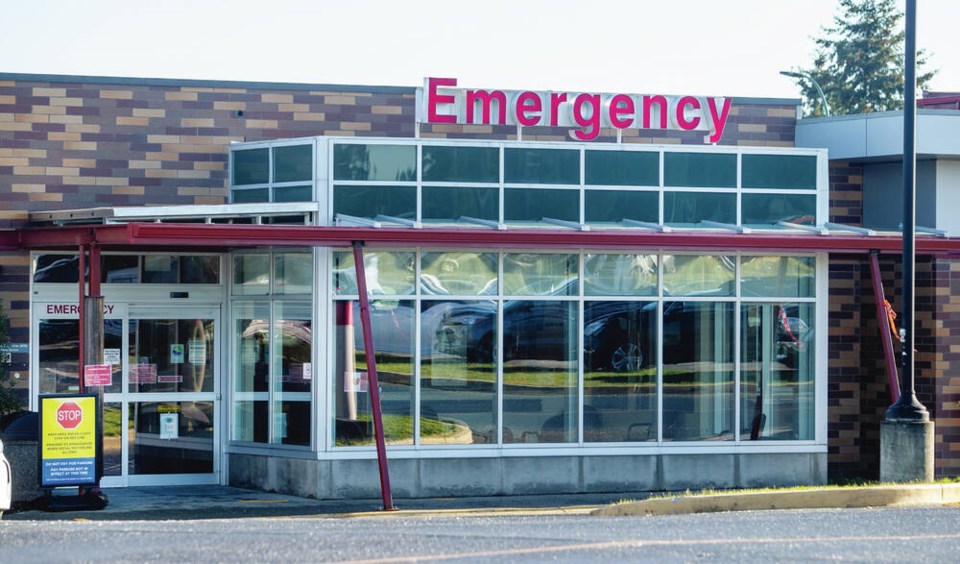Emergency-room physicians at smaller hospitals on the Island, including Saanich Peninsula, are being called on this week to fill shifts in late May and June on an “urgent basis.”
If 16 open shifts in late May and June go unfilled, overnight closings might be required, Saanich Peninsula ER physician Dr. Jeff Unger said, noting the summer and fall look even worse, “with insufficient staffing for up to 30 per cent of our shifts.”
Unger said the hospital has been “scraping by month to month” since last fall, with last-minute coverage by a dwindling staff of physicians working more shifts, out-of-province emergency physicians flying in for short periods, or non-emergency-certified family physicians filling in.
Two of the hospital’s emergency physicians recently left for early retirement and two are now off for personal health reasons, “all attributable to burnout from the last several years of being pushed beyond sustainability,” Unger said.
Saanich Peninsula has been recruiting emergency physicians for a year and a half, yet six new full-time physicians are still needed, he said.
Unger said the current crisis stems from inadequate human resources and increasing patient volumes over the past two years.
B.C. Health Minister Adrian Dix, making an announcement about cancer care on Monday, said the province is working with hospitals across the province to address the issues, which have also been experienced by Langley Memorial and Surrey Memorial hospital emergency departments on the Lower Mainland.
Dix noted the province has hired 38,000 net new health care workers since 2017 and has made significant investments in primary care.
Unger said there are too few beds for the increasing number of people seeking care, an aging population, and people with chronic disease experiencing worsening illness post-pandemic. The result has long been called “bed block,” where admitted patients with nowhere to go remain in emergency department beds.
“This has been a growing issue for decades, but far worse now,” said Unger.
At Saanich Peninsula Hospital, for example, hospital capacity averaged 115 per cent in 2022-23, which Unger called “the worst ever.” At times, it was as high as 150 per cent, he said.
The average admitted patient waited 24 hours for an inpatient bed, “again the worst ever,” said Unger.
It’s not uncommon at Saanich Peninsula to have emergency department waits of up to 11 to 12 hours, with no chairs or space in the waiting room, he said.
Despite “rapid response” and “code orange” disaster protocols for such situations in all hospitals across B.C., “there seems to be very limited cultural, operational and leadership motivation to instituting these on a regular or robust manner,” said Unger. The reason in part is because of its daily occurrence and a “learned helplessness” that’s developed.
The Doctors of B.C. section of emergency medicine said last week that health authorities must empower physicians and nurses to call a “code orange” — a signal to move patients into other areas of the hospital when the emergency department reaches critical limits for admitted patients.
Unger argues there has not been enough baseline funding to staff hospitals and emergency departments, and that retirements have been excessive, leaving remaining health care workers with burnout.
“This is every part of the care team — cleaners, unit clerks, lab and medical imaging tech, care aids, nurses, and physicians,” said Unger.
Saanich Peninsula has also been using “agency nurses” to fill in almost half the nursing shifts over the last year.
On May 13, there were two nurses on shift overnight at the 18-bed emergency department who were also responsible for any critically ill inpatients on the wards and any cardiac arrests in the hospital, he said.
Emergency department patient volumes at Saanich Peninsula have increased 30 per cent since 2019-2020, and May of this year has been the busiest on record. Unger said it’s already 15 per cent more than the average last year, and 45 per cent above pre-COVID levels. “Many days now we care for 70 per cent more emergency department patients than pre-COVID.”
Unger argues that increased patient volumes are attributable to inadequate primary care, limited capacity for urgent visits, “inefficient” Urgent and Primary Care Centes, an aging population, and poor preventative care.
Unger expects the province’s new longitudinal primary care model introduced in February to increase payments for family doctors to alleviate many of the primary-care problems in the coming years, saying that that if UPCCs were run more efficiently, they, too, might help.
>>> To comment on this article, write a letter to the editor: [email protected]



